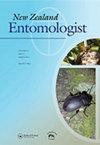Distribution and population trends of two New Zealand endemic aphids (Hemiptera, Aphididae, Aphidinae)
IF 0.4
4区 农林科学
Q4 ENTOMOLOGY
引用次数: 0
Abstract
ABSTRACT Visual observations for colonies of Aphis healyi Cottier on Carmichaelia odorata Benth. bushes and Schizaphis sp. indet. on Aciphylla aurea W.R.B. Oliv. shrubs were made over several seasons at usually 4- to 8-week intervals (but seldom over winter) at two South Island, New Zealand sites (420 and 880 m above sea level, respectively). The presence of aphid parasitoid mummies was also noted. On several occasions, aphid samples were taken to verify species and identify morphs. Both aphid species appear to be monoecious (i.e. not alternating between woody and herbaceous plant hosts), with A. healyi exhibiting cyclical parthenogenesis and overwintering as eggs (i.e. holocyclic) and Schizaphis sp. indet. exhibiting year round parthenogenesis and overwintering as active morphs (i.e. anholocyclic). Aphis healyi colonies were found from December to May with the greatest numbers of colonies being found from December to February. Schizaphis sp. indet. colonies were found throughout the year, including mid-winter, with the greatest numbers of colonies usually being found from October to December. Updated distribution data indicate that both species are more widespread than previously reported, with A. healyi found from the Poor Knights Islands in the north to Southland in the south, and the Schizaphis sp. indet. on Aciphylla spp. found throughout the South Island but not the North Island. This short communication adds population, ecological and biological knowledge on these relatively poorly understood endemic aphid species from New Zealand that informs their conservation status.两种新西兰特有蚜虫(半翅目,蚜虫科,蚜虫科)的分布及种群趋势
摘要/ ABSTRACT摘要/ ABSTRACT摘要/ ABSTRACT灌木和裂茎属植物。关于金银花的研究。在新西兰南岛的两个地点(海拔分别为420米和880米),灌木通常在4至8周的间隔(但很少超过冬季)在几个季节中形成。蚜虫类寄生虫木乃伊也被注意到。在一些情况下,蚜虫样本被用来验证种类和识别形态。这两种蚜虫似乎都是雌雄同株的(即不会在木本植物和草本植物宿主之间交替),其中A. healyi表现出周期性的孤雌生殖,并以卵(即全循环)和Schizaphis sp. indet的形式越冬。表现出全年孤雌生殖和越冬的活跃形态(即无环)。12月至5月为健康蚜虫的孳生期,12月至2月为孳生期。裂胞属;蜂群全年都有,包括冬季中期,蜂群数量最多的通常是在10月到12月。最新的分布数据表明,这两个物种的分布范围比以前报道的要广,其中A. healyi从北部的Poor Knights群岛到南部的Southland,以及Schizaphis sp. indet。遍布南岛但不分布于北岛的针叶树属。这种简短的交流增加了对这些相对不太了解的新西兰特有蚜虫物种的种群、生态和生物学知识,为它们的保护状况提供了信息。
本文章由计算机程序翻译,如有差异,请以英文原文为准。
求助全文
约1分钟内获得全文
求助全文
来源期刊

New Zealand Entomologist
ENTOMOLOGY-
CiteScore
0.70
自引率
33.30%
发文量
3
审稿时长
>12 weeks
期刊介绍:
The invertebrate diversity of New Zealand is of great interest worldwide because of its geographic isolation and geological history. The New Zealand Entomologist plays an important role in disseminating information on field-based, experimental, and theoretical research.
The New Zealand Entomologist publishes original research papers, review papers and short communications. We welcome submissions in all aspects of science regarding insects and arthropods in a New Zealand or Australasian setting. The journal’s subject matter encompasses taxonomy, phylogenetics, biogeography, biological control and pest management, conservation, ecology and natural history.
The journal is the official publication of the Entomological Society of New Zealand. Papers published or submitted elsewhere for publication will not be considered, but publication of an abstract or summary elsewhere (e.g. conference proceedings) does not preclude full publication in the New Zealand Entomologist. Accepted papers become copyright of the Entomological Society of New Zealand. The journal is published in English, but we also welcome publication of abstracts in Maori.
 求助内容:
求助内容: 应助结果提醒方式:
应助结果提醒方式:


